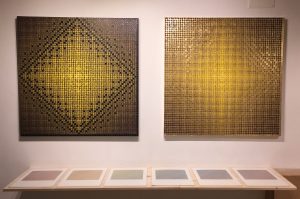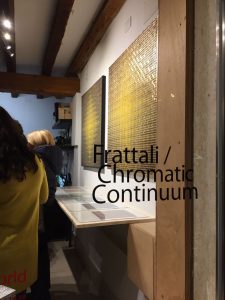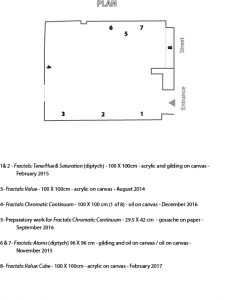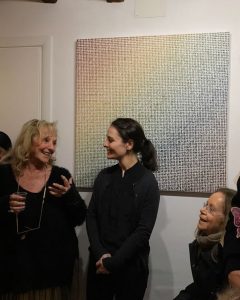Solo exhibition at ARTLIFE Gallery – Venice, Italy – 18 February / 18 March 2017
Fractals: Chromatic Continuum Fractals: Chromatic Continuum
Fractal geometry was formalised in 1975 by Benoit B. Mandelbrot. It extended the classical framework of Euclidean geometry that dominated for centuries in western philosophical and scientific thinking. Mandelbrot describes a fractal as ‘a rough or fragmented geometric shape that can be split into parts, each of which is (at least approximately) a reduced-size copy of the whole’. The fractal model mirrors distinctive types of rough, broken or irregular natural formations. It is a self–similar, iterated and detailed mathematical construct. Every unit in it can equally correspond to a whole and a part of a bigger whole at the same time. As consequence, fractals are ideally endless. Mandelbrot expanded the notion of dimensions by introducing the fractal dimension. In theory, fractals can be eternally broken down into every time smaller pieces. For that reason, they never embody indivisible, closed and whole geometrical entities (a point, a line, a plane or a volume) but they rather exist in between dimensions. Based on fractal geometry, Mandelbrot claimed that irregularity in nature was not simply a random phenomena, but that the degree of irregularity in a natural forms remains constant at different scales, like a sort of regular irregularity. This relation of patterns inside patterns that is repeated across scales, is a property of self-similarity. While finer details can always be found at smaller scales, new emergent phenomena appear at larger ones.
The chromatic compositions of the paintings from in this exhibition follow fractal relations between very subtle degradations of colours. These colour relations are repeated at different scales of magnification within each painting. These works depict rhythmical compositions where the colour dynamics resembles the properties of wave propagation, in particular, the properties of light: in between waves and particles. The images in these paintings are emergent properties of the tonal differences between the accumulated coloured units. Due to the level of details, the relation between the parts and the whole is markedly a main characteristic of these paintings. Depending on the distance taken by the viewer, different colour dynamics can then be established. Due to light reflection, metal leaf in some of the paintings affects dramatically the perception of colours. This makes the perception of these works more challenging accentuating the dynamic relation between the viewer and the works.
The group of seven paintings Fractals: Chromatic Continuum presents colour degradations that together compose a whole chromatic wheel. Six of these paintings show a passage between a primary and a secondary colour. The use of same tones for finishing one work and beginning with the next one connects all of these paintings and creates a chromatic continuum. These six works capture on a 1/36 scale of magnification from 6 detailed areas of the seventh composition. This latter depicts a degradation that integrates all the colours of those six paintings in one. Due to the amount of detail, when the six works are looked at from close, the degradation is almost imperceptible. Yet when a greater distance is taken this gradience appears more clearly. This change of perception, depends on the perspective from where the paintings are observed and is inspired on the emergent properties that are characteristic of fractals.
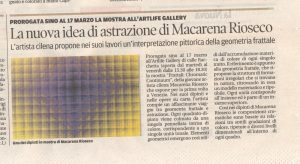
Links to the works
Preparatory work for Fractals: Chromatic Continuum
